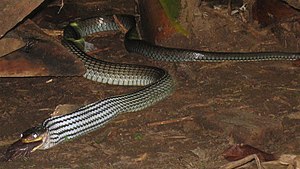Mussuranas
| Mussuranas | ||||||||||||
|---|---|---|---|---|---|---|---|---|---|---|---|---|

Mussuranas ( Clelia ) |
||||||||||||
| Systematics | ||||||||||||
|
||||||||||||
| Scientific name | ||||||||||||
| Clelia | ||||||||||||
| Fitzinger , 1826 |
Mussuranas ( Clelia ) are a genus of the adder . The species Clelia clelia is best described . Although mussuranas are medium to large-sized snakes, they are rarely found in nature. The genre is also rarely represented in collections.
Systematics
The following seven species of this genus are known:
- Clelia clelia ( Daudin , 1803)
- Clelia equatoriana ( Amaral , 1924)
- Clelia errabunda Underwood , 1993
- Clelia hussami Morato , Franco & Sanches , 2003
- Clelia Langei Reichle & Embert , 2005
- Clelia plumbea ( Wied , 1820)
- Clelia scytalina ( Cope , 1867)
The following species, which used to belong to Clelia , have now been separated into their own genus Mussurana .
- Mussurana bicolor ( Peracca , 1904)
- Mussurana montana ( Franco , Marques & Puorto , 1997)
- Mussurana quimi ( Franco , Marques & Puorto , 1997)
Clelia belongs to the tribe Pseudoboini within the subfamily Dipsadinae . According to Vidal et al. the following system:
| Pseudoboini |
|
||||||||||||||||||||||||||||||||||||||||||
|
|
Accordingly, the species that are more closely related to Drepanoides were moved to the genus Mussurana . The sister genus of Clelia is Boiruna .
features
Juvenile mussuranas have a white collar and are usually reddish with black stripes. They change color as soon as they grow up; most species are then darkly colored. They reach a head-torso length of 57 to 280 centimeters, with Clelia plumbea being the largest species. Females generally grow larger than males. The mating season is probably all year round, but it is not known whether this also applies to species such as C. rustica that occur in the cooler habitats . Clelia are oviparous , i.e. egg-laying. The number of eggs depends on the size of the female; clutch sizes between 4 and 30 eggs have been observed.
distribution
The snakes of the genus Clelia are found mainly in South America . Clelia clelia has the largest range, reaching in the north to Mexico and in the south to Uruguay . Clelia errabunda is endemic and probably extinct on the Antilles island of St. Lucia .
Web links
Individual evidence
- ↑ a b c Lígia Pizzatto: Body size, reproductive biology and abundance of the rare pseudoboini snakes genera Clelia and Boiruna (Serpentes, Colubridae) in Brazil . In: Phyllomedusa . tape 4 , no. 2 , 2005, ISSN 1519-1397 , p. 111-122 , doi : 10.11606 / issn.2316-9079.v4i2p111-122 .
- ↑ Globaltwitcher ( page no longer available , search in web archives ) Info: The link was automatically marked as defective. Please check the link according to the instructions and then remove this notice.
- ^ A b Clelia in The Reptile Database
- ^ A b Francisco L. Franco, Otavio AV Marques, Giuseppe Puorto: Two New Species of Colubrid Snakes of the Genus Clelia from Brazil. In: Journal of Herpetology. Volume 31, No. 4, 1997, pp. 483-490, doi: 10.2307 / 1565599 .
- ↑ Nicolas Vidal, William R. Branch, Olivier SG Pauwels, S. Blair Hedges, Donald G. Broadley, Michael Wink, Corinne Cruaud, Ulrich Joger, Zoltán T. Nagy: Dissecting the major African snake radiation: a molecular phylogeny of the Lamprophiidae Fitzinger (Serpentes, Caenophidia) . In: Zootaxa . tape 1945 , no. 1 , 2008, ISSN 1175-5326 , p. 51-66 , doi : 10.11646 / zootaxa.1945.1.3 .
- ↑ Norman J. Scott Jr, Alejandro R. Giraudo, Gustavo Scrocchi, Aida Luz Aquino, Pier Cacciali, Martha Motte: The Genera Boiruna and Clelia (Serpentes: Pseudoboini) in Paraguay and Argentina . In: Papéis Avulsos de Zoologia (São Paulo) . tape 46 , no. 9 , 2006, p. 77-105 , doi : 10.1590 / S0031-10492006000900001 .
- ^ Extinct Reptiles